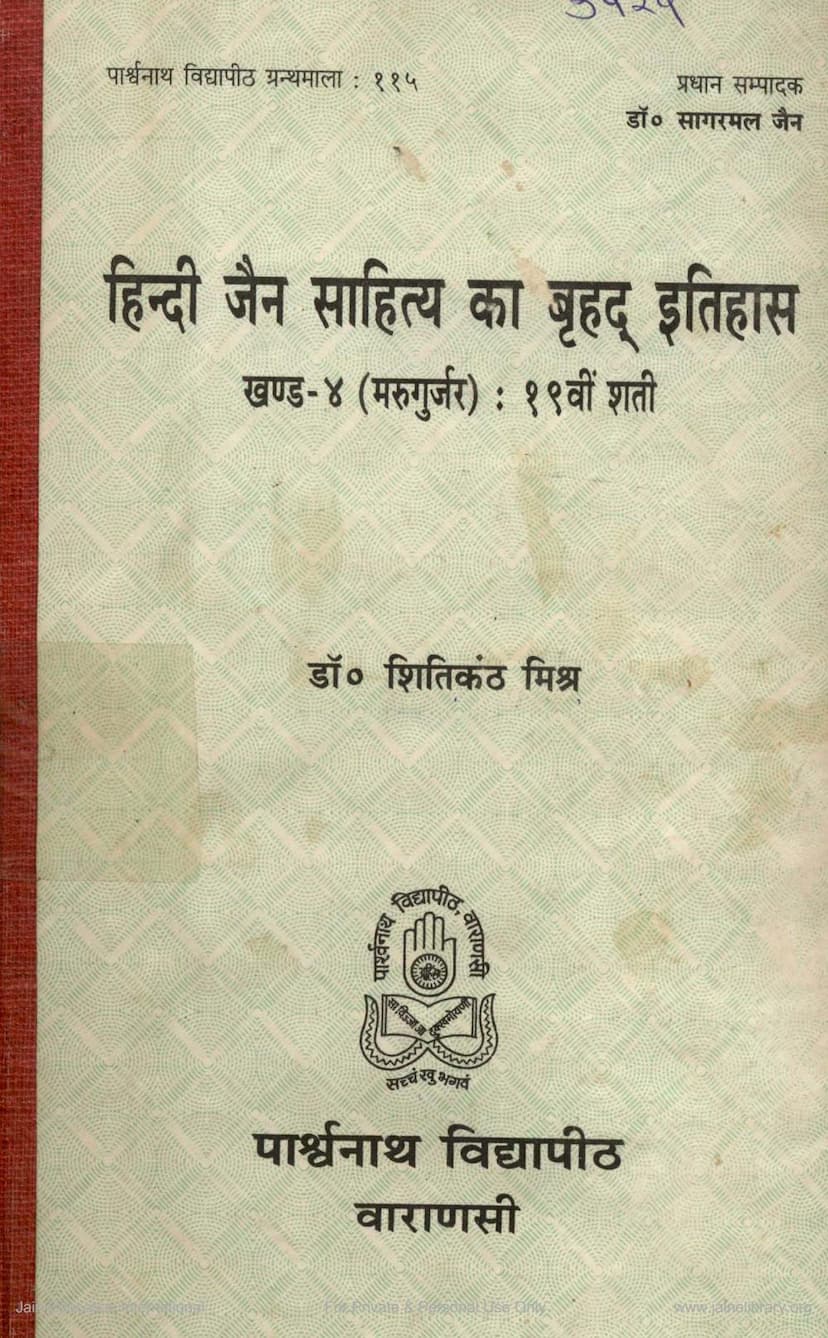Hindi Jain Sahitya Ka Bruhad Itihas Part 4
Added to library: September 1, 2025

Summary
This document is the fourth volume of a comprehensive history of Hindi Jain Literature, titled "हिन्दी जैन साहित्य का बृहद् इतिहास, खण्ड-४ (मरुगुर्जर) : १९वीं शती" (A Comprehensive History of Hindi Jain Literature, Vol-4 (MaruGurjar): 19th Century). Authored by Dr. Shitikanth Mishra and published by Parshwanath Shodhpith, Varanasi, it was first published in 1999.
The book meticulously details the political, social, and cultural backdrop of 19th-century India as it pertains to the development of Hindi Jain literature. It then provides an extensive overview of Jain Hindi literature from the 19th century, listing and briefly describing the works of numerous Jain authors.
Key Themes and Content:
-
Historical Context (Chapter 1): The first chapter sets the stage by discussing the prevailing political landscape of 19th-century India, including:
- The decline of the Mughal Empire and the rise and fall of Maratha power.
- The presence of various regional states and principalities.
- The increasing influence and eventual dominance of European trading companies, particularly the British East India Company.
- The socio-economic conditions, including the exploitation of farmers and artisans.
- The cultural and intellectual shifts of the era, including the influence of the Renaissance and figures like Raja Ram Mohan Roy.
- The Indian Mutiny of 1857 and its impact.
- The religious and social environment, with a specific focus on the state of Jainism during this period. This includes discussions on the evolution of Jain practices, the influence of reform movements like the Sthanakvasi sect, and the activities of prominent Jain figures and institutions.
-
Literary Survey (Chapter 2): The second and largest chapter is a detailed catalog of Jain authors and their literary contributions from the 19th century. It lists authors alphabetically, providing:
- Their names.
- Their lineage or guru-disciple tradition.
- The titles of their significant works, along with their composition dates and sometimes brief descriptions or opening/closing lines.
- Information about the manuscripts, their preservation, and publication.
- The authors covered span a vast range, from well-known poets and scholars to those whose works are less widely recognized, showcasing the breadth of literary activity within the Jain community. The sheer number of authors and works listed, often with intricate details about their guru-parampara and manuscript locations, highlights the extensive research undertaken for this volume.
-
Works by Unknown Authors and Non-Jain Creators (Chapter 3): The third chapter addresses literary works whose authors are unknown or who were non-Jain but contributed to the MaruGurjar (Hindi) literary tradition. This includes an analysis of the language and style of these works and their historical context.
-
Gady (Prose) Literature: Throughout the book, and particularly in the third chapter, there is a focus on the development of prose literature in the MaruGurjar language during the 19th century. It highlights how various prose forms like commentaries (vritti, tatthva), narratives (charitra, katha), and instructive texts (updesh, nitishastra) evolved and were utilized for religious, philosophical, and social discourse.
-
Language and Style: The book notes the prevalent "MaruGurjar" language, a blend of Hindi, Gujarati, and Rajasthani, which was commonly used by Jain poets and scholars. It also observes the gradual influence of modern Hindi (Khadiboli) towards the end of the 19th century.
-
Literary Significance: The authors and scholars mentioned in the book contributed significantly to the Jain tradition, propagating religious teachings, philosophical ideas, and ethical principles through their literary works. The book emphasizes that Jain literature is not merely didactic but also rich in poetic merit, narrative skill, and historical information, making it a valuable resource for understanding not just Jainism but also the broader cultural and linguistic landscape of 19th-century India.
In essence, this volume provides an invaluable and encyclopedic resource for scholars and enthusiasts of Jain literature, Indian history, and linguistics, offering a comprehensive catalog and analysis of the literary output of the Jain community during a pivotal century in Indian history.